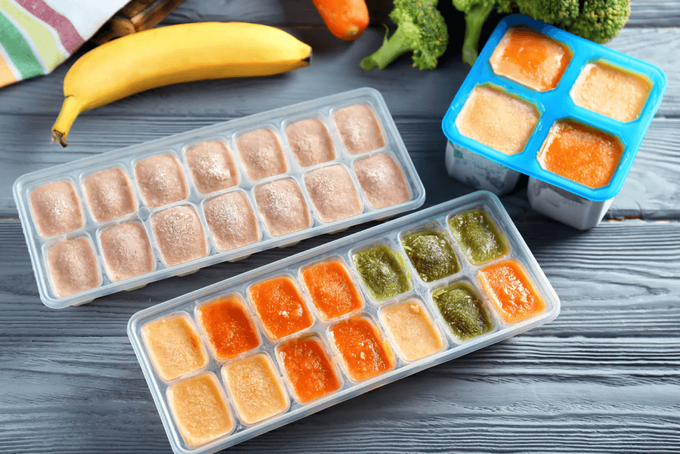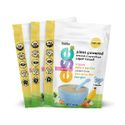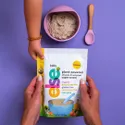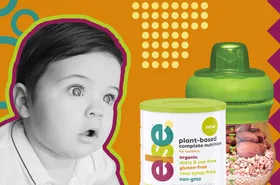Frozen Baby Food: Recipes, Preparation, Storage, and Safety
As parents, we always look for ways to ensure our babies eat the healthiest and most nutritious foods. Frozen baby food emerges as a great choice for nutritious and convenient meals
Published June 13, 2024

As parents, we always look for ways to ensure our babies eat the healthiest and most nutritious foods. Frozen baby food emerges as a great choice for nutritious and convenient meals. Whether whipping up homemade purees or opting for store-bought varieties, freezing baby food ensures your little one enjoys a variety of healthy flavors on your schedule.
This guide dives into the benefits, preparation, and smart storage of frozen baby food, making it easier for you to nourish your baby with both love and goodness.
Advantages of Frozen Baby Food
Frozen baby food is a surprisingly nutritious and convenient option for feeding your little one.
- Nutrient Preservation: Since the food is frozen soon after preparation, it retains more nutrients than canned or jarred foods, which often undergo heat processing.
- Convenience: Frozen baby food is a time-saver for parents balancing work and family. Preparing and freezing meals in batches means you always have healthy options on hand.
- Waste Reduction: Freezing homemade baby food in appropriate portions helps minimize waste, as you only thaw what you need.
- Cost-Effective: Making baby food in bulk and freezing it can be more economical than purchasing ready-made options. It also allows you to take advantage of seasonal produce.
Homemade vs. Store-Bought Frozen Baby Food
Deciding between homemade and store-bought frozen baby food can pivot on several factors, each with its own unique set of advantages and trade-offs:
Homemade Frozen Baby Food Pros & Cons
- Tailored Nutrition: You have the freedom to choose high-quality, organic ingredients and tailor meals to your baby’s nutritional needs and taste preferences.
- Budget-Friendly: Making baby food in bulk can be cost-effective, especially if you use seasonal produce or ingredients already on your weekly shopping list.
- Customizable: You can adjust textures and ingredients as your baby grows and their eating skills develop, something off-the-shelf products can't offer.
- Time Investment: Preparing, cooking, pureeing, and freezing baby food is time-consuming. It requires a level of planning and commitment that might be challenging for busy parents.
- Nutritional Knowledge: Ensuring each homemade meal is nutritionally balanced demands a good understanding of infant nutrition.
Store-Bought Frozen Baby Food Pros & Cons
- Convenient: Perfect for busy schedules, these options require no preparation besides thawing and reheating.
- Consistent: Manufactured foods for babies are crafted by nutrition experts to cater to their specific dietary needs at different growth stages. However, the quality of these products can vary. That's why recognitions like the Clean Label Awards are crucial. They help parents ensure they're choosing high-quality products, verified for safety and nutritional value. This assurance is particularly important since not all manufactured foods are created equal, and the award serves as a reliable benchmark for product quality.
- Variety: Offers a wide range of flavors and combinations, some of which might be difficult or impractical to prepare at home.
- Higher Cost: Generally, pre-made frozen baby foods can be more expensive than making meals at home.
- Limited Customization: What you see is what you get – there’s little room for tweaking ingredients or textures to suit your baby’s preferences.
3 Frozen Baby Food Recipes
Creating your own baby food at home can be both fun and rewarding. Here are three simple, nutritious recipes that are perfect for freezing and serving later. Each recipe is designed to be easy to prepare, delicious, and full of the nutrients your growing baby needs.
1. Sweet Potato and Carrot Puree:
This puree is rich in beta-carotene, vitamins A and C, and fiber. These nutrients support eye, skin, and immune health.
- Ingredients: 2 sweet potatoes, 3 carrots
- Instructions: Peel and chop the sweet potatoes and carrots into small pieces. Steam or boil until tender, about 15-20 minutes. Blend in a food processor or with a hand blender until smooth. Allow to cool, then portion into ice cube trays or small containers and freeze.
- Note: adding a scoop of Else Nutrition’s iron-fortified product can enhance the nutritional value of the homemade puree.
2. Pea, Pear, and Avocado Mash
This mash offers a good mix of healthy fats, vitamins, and fiber, all important nutrients for brain development and digestion.
- Ingredients: 1 cup of peas (fresh or frozen), 1 ripe pear, 1/2 ripe avocado.
- Instructions: Steam the peas until tender, about 10 minutes. In a bowl, mash the steamed peas with the pear and avocado until you achieve a smooth consistency. Cool it down, portion into containers, and freeze.
» If your baby is an avo fan, check out this recipe for a strawberry, banana, and avocado smoothie!
3. Banana-Blueberry Yogurt Swirl:
This yogurt swirl is packed with antioxidants, potassium, and probiotics for gut health
- Ingredients: 2 ripe bananas, 1/2 cup blueberries, 1/2 cup full-fat plain yogurt (or dairy-free alternative).
- Instructions: Blend bananas and blueberries together until smooth. Mix in the yogurt to create a swirl effect. Portion the mixture into containers and freeze.
Just a note: always check for any potential allergies and consult with your pediatrician before introducing new foods to your baby's diet.
» Here's how you can safely introduce allergens to your baby
Tips for Making Baby Food at Home for Freezing
Making baby food at home for freezing is a great way to ensure your little one gets nutritious and fresh meals. Here are some helpful tips to make the process easier and more efficient:
- Puree to the Right Texture: Depending on your baby’s age and eating skills, puree the food to the appropriate texture. Younger babies need smoother purees, while older babies can handle more texture.
- Cool Before Freezing: Allow the food to cool completely before freezing. This helps maintain the texture and taste when thawed.
- Use Appropriate Containers: Freeze purees in ice cube trays or small BPA-free containers or pouches. This makes it easy to thaw individual servings.
- Avoid Contamination: Use clean utensils and containers to avoid introducing bacteria. Label your containers with the date of preparation.
- Maximize Variety: Prepare a variety of fruits, vegetables, grains, and proteins to ensure your baby gets a wide range of nutrients.
- Batch Cooking: Save time by making large batches and freezing them in portions. This ensures you always have something on hand for meal times.
- Introduce New Foods Gradually: Follow pediatric recommendations for introducing new foods to your baby, typically one at a time to monitor for any allergic reactions.
- Stay Organized: Keep an inventory of what types of food you have frozen and their preparation dates. Rotate the stock so that the oldest foods are used first.
Incorporating Frozen Baby Food into Your Baby’s Diet
Introducing frozen baby food into the diet of infants under 12 months can be a strategic way to ensure they receive a range of nutrients while easing the meal prep burden for parents.
For infants just beginning to explore solids, usually around 6 months, start with single-ingredient purees. Thawed frozen foods like sweet potato, carrot, or pea purees offer the perfect consistency for early eaters. Gradually introduce these foods by thawing small portions overnight in the refrigerator, ensuring they're brought to room temperature or slightly warmed before serving. This gradual introduction helps infants adjust to new tastes and textures while allowing parents to monitor for any potential food sensitivities or allergic reactions.
» Here are some signs that indicate your baby is ready to start solid foods
As your infant grows and becomes more accustomed to solids, you can begin combining different food purees for more complex flavors and nutritional benefits. For instance, mix thawed apple puree with oatmeal for a wholesome breakfast or blend vegetable purees for a nutritious lunch.
At this stage, it’s also important to progressively introduce more texture to their foods. Mashing thawed fruits like bananas or avocados with a fork, rather than pureeing them, can help in this transition.
Keep in mind, each infant's readiness for new textures and foods can vary, so it’s essential to follow their cues and consult with a pediatrician if you have any concerns about their feeding or nutritional needs.
Frequently Asked Questions
How long can you store homemade baby food in the freezer?
Homemade baby food can typically be stored in the freezer for up to 3 months. It's essential to label each container with the preparation date to keep track.
Can you refreeze thawed baby food?
It’s not recommended to refreeze thawed baby food. Once thawed, either in the refrigerator or at room temperature, it should be consumed within 24-48 hours and should not be refrozen for safety reasons.
How do you know if frozen baby food has gone bad?
Signs that frozen baby food has gone bad include an off smell, discoloration, or the presence of ice crystals, which can indicate freezer burn and a loss of quality. Always check each portion before serving.
What are the best foods to start with for freezing?
Great options for freezing as baby food include pureed fruits like apples, pears, and bananas, as well as vegetables like sweet potatoes, carrots, and peas. These foods freeze well, retain their nutritional quality, and generally reheat to a baby-friendly texture.











